As a wildlife photographer, I'm always looking for ways to capture great images of animals in their natural habitat. One technique that I've found incredibly effective is using a custom-made DIY DSLR camera trap. This is a camera setup that is triggered by animal movement.
This article will walk you through the process of building a DIY DSLR camera trap that you can use to capture amazing wildlife photos.
gear and equipment
The first step in building a camera trap is to gather the necessary equipment and equipment. One thing to note here is that the scene is lit with flash, so you don't need expensive or the latest and greatest equipment.
Here's what you need:
- Digital single-lens reflex camera. I used a 12 year old Canon T3i for this project, but any DSLR will work.
- lens. I used the 18-55mm kit lens that came with my Canon T3i, but again, any lens will work. (I think the wider the better)
- camera case. The case is made of Pelikan 1300, which is highly waterproof, shockproof, and dustproof.
- flash case. I used an inexpensive Apache 1800 case for the flash unit.
- transparent acrylic. This is what I used as a flash window.
- Large UV filter and step-up ring. Use as a lens cover for camera case.
- PIR sensor/trigger. I used a Camtraptions V3 PIR sensor for my setup. The same goes for wireless transmitters and receivers.
- battery. I used a battery grip and rechargeable AA batteries for my Canon T3i. The entire setup runs on 20 AA batteries. I always have 40-50 AA batteries in storage, on a charger, or in the field.
- aa battery charger. I use this charger from Amazon that can charge up to 16 batteries at once. During the summer, AA lasts for more than a month at a time, but in Wisconsin's harsh winters, it takes 5 to 7 days for AA to die.
- flash. I used two Nikon SB-24 flashes. You can get this pretty cheap on eBay. I specifically used these flashes because they can stay in standby mode for a long time and can be quickly activated and triggered.
- ram mount. I used the Ram mount in my build, which made it easy to mount the camera and flash in any direction possible.
- Ejangar. Ezhanger is a tool used to screw the sensor/trigger into wood.
- Apple Air Tag. It wasn't mentioned in the video (I forget), but as a safety measure in case someone tries to take away your setup or parts, you can purchase an Apple Airtag and hide it under peel-and-pack foam to attach it to each case. I placed it in of setup.
Once you have all the necessary equipment, you can start building and eventually deploying your camera trap. Here's how I did it:
Step 1: Drill a hole in the camera case
The first step is to cut a hole in the camera case for the lens to pass through. I used a hole saw to cut a hole in the lid of the Pelican case, making sure to leave enough space around the hole for the lens to move.
![]()
I then went to a local hardware store and purchased a PVC piping attachment to use as a makeshift lens hood. To plug this hole, I used a large UV filter screwed into a step-down ring epoxied to a PVC piping attachment.
![]()
The reason I did this is so that if the filter were to break or become damaged, it would be easier to unscrew and replace it than if I epoxied the UV filter directly to the PVC attachment.
Step 2: Attach the camera to the case
I then mounted the camera inside the Pelican 1300 case using Pelican case peel and pack foam. This foam also acts as a noise damper. DSLR cameras are notoriously noisy, but it's packed tightly inside this foam and completely silent when the case is closed.
![]()
I was then able to use some wood shavings inside the case to screw in the ball head base of the outer ram mount.
Step 3: Build the camera base
Once the case was all assembled, I needed to build the base of the camera. After my first attempt failed, I decided to screw together some of his scrap 2x4s and 2x6s and spray paint them black. I then attached a large ram mount (I think it's the largest possible) to the base.
![]()
My first attempt was unsuccessful, so again, do some research and read up on compatible weights for ram mounts.
Step 4: Attach the flash to the case
I then installed the flash inside the Apache 1800 case using the peel and pack foam that came with the case. For the flash case, I cut out a window in the top of the case and epoxied some clear acrylic I had on hand.
![]()
Once again, using wood shavings inside the case, I was able to screw in the ball head base of the outer ram mount.
Step 5: Understand your specialized gear
Next, familiarize yourself with Camtraptions PIR sensors, triggers, and receivers. How do I put this politely…read the manual from cover to cover, do as many tests as you can at home, then at your mom's house, then at your friend's house.
Although I kept the manual on my phone for the first six months of my DSLR camera adventure, I cannot underestimate the importance of thoroughly learning and understanding PIR sensors. It's confusing at first, but once you read everything and run multiple tests, once you're dialed in, you won't need to touch it again.
Step 6: Scouting
Another important part of successful camera trapping is scouting areas where wildlife is active. I am very fortunate in the sense that I know avid outdoor enthusiasts who appreciate my work. Therefore, we regularly receive information about the habitats of wild animals.
Even with the tips, scout and investigate the location yourself before deploying your DSLR camera trap. For the fox series, we tracked and scouted foxes for three days until we found a suitable location/configuration to set up the camera trap.
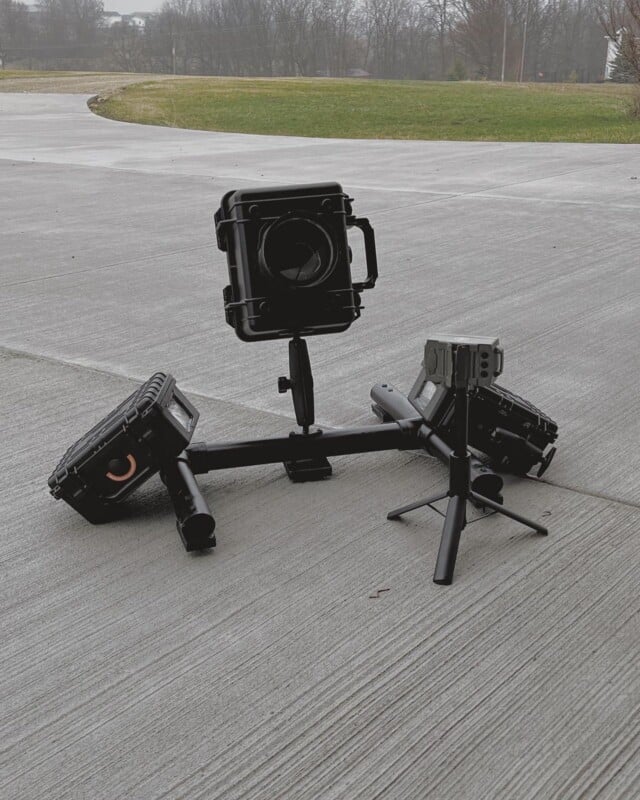
Step 7: Deploy DSLR camera traps and camera settings
congratulations! You're ready to deploy your DSLR camera trap…but how should you set it up and what should your camera settings be? It helps if you have some experience lighting scenes with strobes, but No need to worry if you don't have one.
focus and aperture
The first thing you need to address in your setup is your focus. First, I use an aperture of at least f/8 and sometimes up to f/11 because it gives me the best chance of focusing on the animal. After all, let's be real, you have no control over where these creatures are placed in your scene. On top of that, manually focus on the scene and once you reach your desired focus, tape all the buttons/rings on the lens with gaffer tape.
synchronous speed
The next thing you need to understand is that all cameras have a “sync” speed, which is the fastest shutter speed at which the camera can successfully handle flashes in the scene. If you exceed this sync speed, your scene will not be properly lit and you will end up with dark areas in your work.
My Canon T3i's sync is 1/250 (I think this is standard for most cameras). I use a shutter speed between 1/100 and 1/160 because I'm using a flash to illuminate the scene and the animals don't move quickly or cause motion blur. It depends on the scene, composition, and whether you want to incorporate more ambient light into the image. The shorter the shutter speed you use, the more ambient light is likely to be captured in the scene.
ISO
Finally, I set the ISO to auto and limit the camera to no more than 3200. Regarding flash power, it depends on each scene and development. What I usually do is trigger the setup myself to test that everything is working properly and check the output of the flash. Usually between 1/4 and 1/8. If you can keep this value low, there will be less need to replace the battery.
When it comes to flash placement, I always try to have a key light and a backlight. It creates the biggest separation but has never betrayed me yet.
Step 8: Luck and patience
Camera trapping is equal parts fun and frustrating because it's part luck and part patience. You can do all the scouting and set up the perfect composition, but if the animal doesn't come into the trap or the composition doesn't look the way you intended, you're totally out of luck.
You need to collect the number of animal butts you caught to create a coffee table book “Animal Butts”.
In the Fox series, we looked at the timestamps and found that a curious fox was trapped just an hour after the trap was deployed, and returned only once in the following month. Another good luck was the fox pose. If you watch the whole series, you'll see that the fox was about to give me a classic butt shot, but the flash must have gotten the fox's attention.
![]()
![]()
![]()
![]()
![]()
![]()
![]()
![]()
![]()
At this point the fox turned around and gave me a strange pose with its paws raised and staring directly into the lens. I couldn't have asked for a better pose or composition.
![]()
Finally, you need patience. Animals come and go as they please, so it takes time. I made the camera trap over a year ago and set it up 5-6 times before getting the Winter Fox series. Other creatures visited as well.
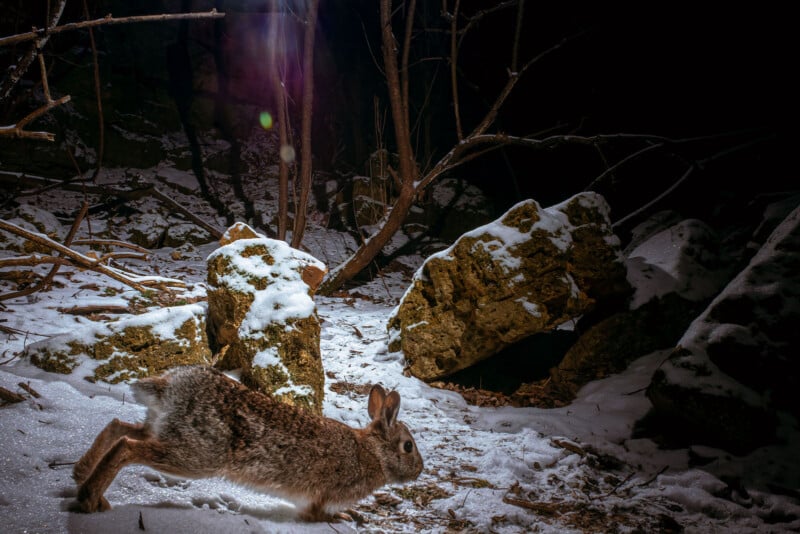
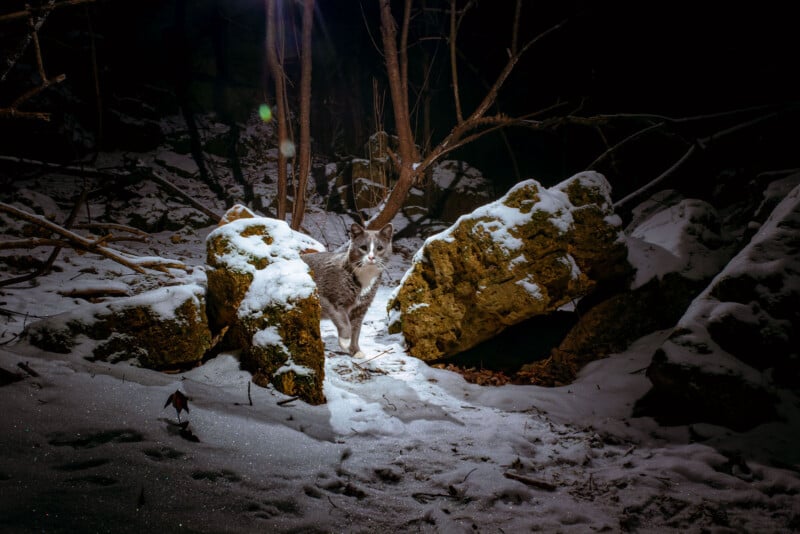
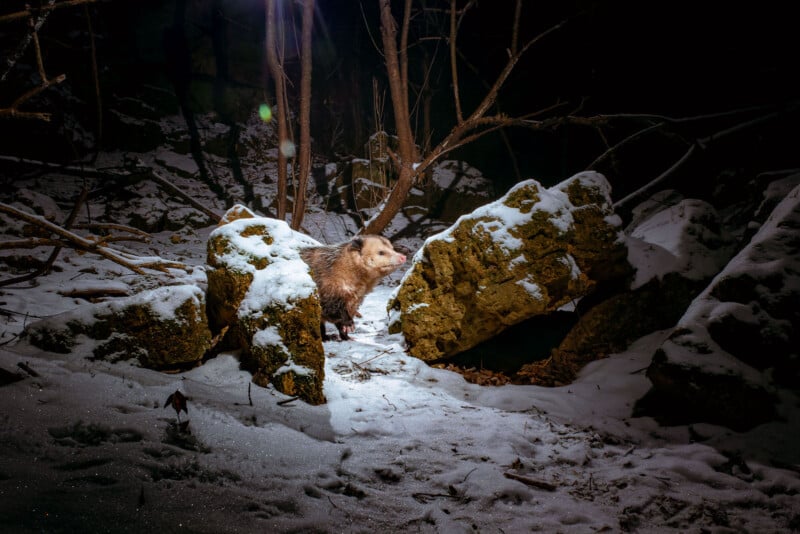
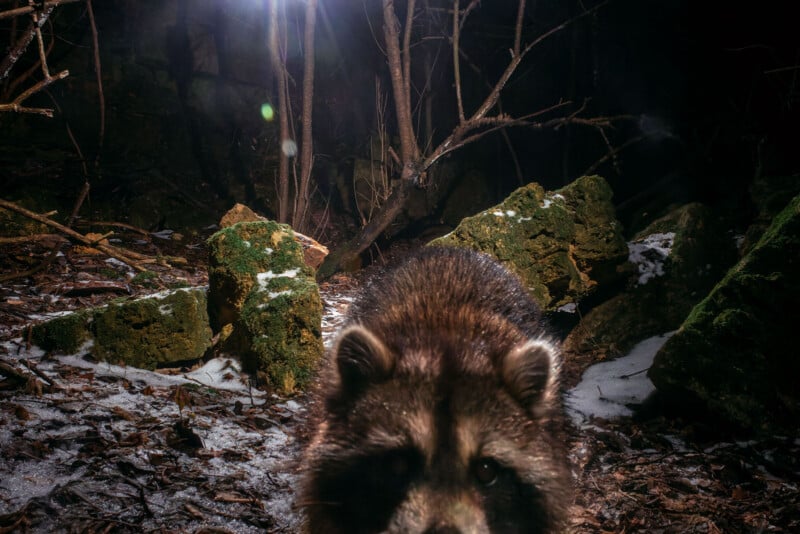
Build your own camera trap and try your best to capture amazing wildlife photos.
About the author: Ross Khalid is a photographer based in Wisconsin. More information about his work can be found on his website, Facebook, twitter,Instagram.


